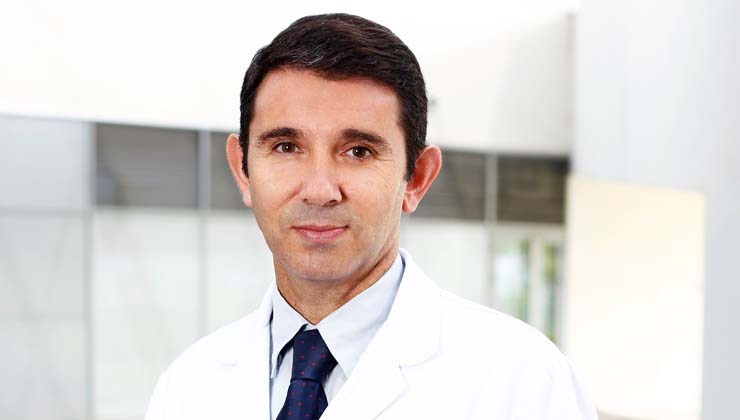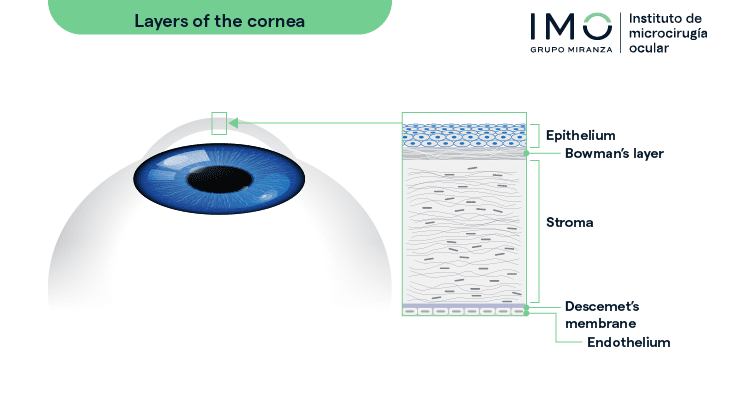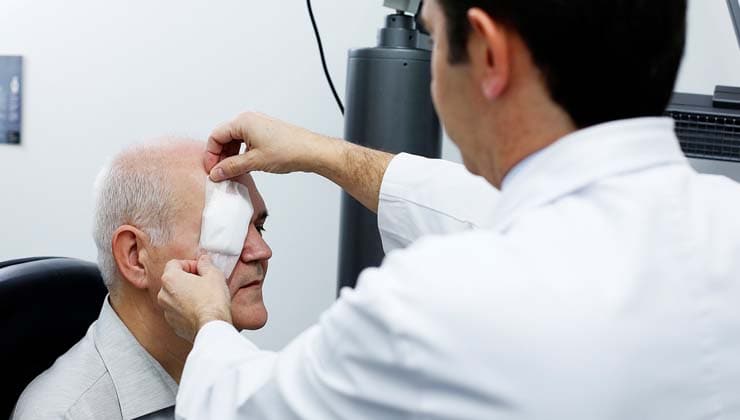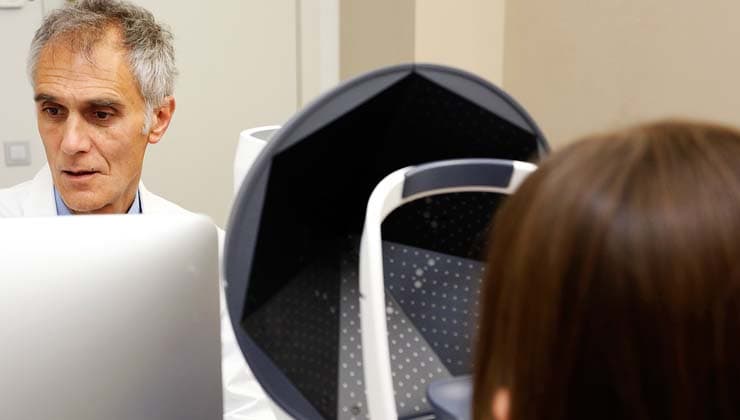Advances to treat the cornea, the window of the eye, and recover vision
7 de April de 2021
One of the major advances that has allowed cornea (and therefore vision) to be restored, the last years, has been partial corneal trasplantation or stell cell transplantation. In IMO Miranza Group, we carry out important research projects, lead by IMO Foundation, with the objective to find a solution or improve the prognosis of patients suffering from diseases or injuries of the cornea.

Dr. Óscar Gris is an expert in the treatment of corneal diseases.
Corneal transplant: when is it done?
Corneal transplantation is a surgical procedure performed on patients with damage to this area of the eye as a result of an accident or diseases that cause certain opacities or changes in their shape, for example, in severe cases of keratoconus. In this sense, “the main goal of this intervention is to heal or improve the patient’s vision, and for this we completely or partially transplant the damaged cornea, replacing it with a healthy one,” explains Dr. Óscar Gris, specialist in various corneal transplantation techniques.
Transplanting just part of the cornea
There are several surgical techniques that can be used for corneal transplants, adds Dr. Gris: “We can replace the front or back, depending on each patient. One of the most widespread techniques – DMEK – is an endothelial transplant of Descemet’s membrane, which we started using more than ten years ago with very good results.”

Layers of the cornea
Currently, more than 50% of our corneal transplants are performed using the DMEK technique, as we have many patients with problems in this area called the endothelium
Dr. Óscar Gris
A safe surgery, performed by experts
One of the great advantages of DMEK is that it is less invasive. “In addition, the patient’s recovery period is shorter, their prognosis is much better and there are fewer postoperative complications in the short as well as the long term.”. “In most cases, our operated patients recover 95% of their vision, and the risk of rejection of the transplant is very low (less than 3%) “, continues Dr. Gris. However, as the expert notes, it is important to emphasize that:” Not all patients are candidates for this type of intervention and it is necessary to do an ophthalmological examination in advance and evaluate whether this is the best option”.
It is very important to trust experienced ophthalmology experts who specialize in this type of procedure so that you can also avoid possible complications
Dr. Óscar Gris
Corneal stem cell transplant
If the corneal injury is very severe or very extensive, surgery is the only effective solution. In parallel, “for a couple of decades now, we have also transplanted stem cells from the cornea to solve the problems of people with certain types of changes in the ocular surface,” explains Dr. Gris. As for the source, stem cells can be obtained from a donor or from the patient’s other eye (if he is healthy) by growing them in a laboratory for subsequent transplantation.

When the corneal injury is very serious or widespread, surgery is the solution
We also perform corneal stem cell transplants to address the problems of people with certain types of ocular surface diseases
Dr. Óscar Gris
Individual techniques depending on the patient’s state
“At the IMO Miranza group, we apply a very personalized approach to medical and surgical interventions. We aim to resolve the patients vision problems, according to each individual case, depending on the speed of the disease evolution and the particularities of the affected area of the cornea,” the expert says. He adds: “We are the pioneers in corneal transplantation: Between my colleague Dr. Jose L. Güell and myself we perform over 200 transplants per year in Barcelona.”
In 90% of cases, the transplanted tissue is viable. This makes us proud especially because it means that we are helping to improve the vision and therefore the quality of life of the patients who visit us
Dr. Óscar Gris
New advances in the treatment of corneal injuries
In addition to their day-to-day work in the diagnosis and treatment of eye diseases, the ophthalmologists of the IMO Miranza Group also contribute to the advancement of ophthalmology and lead im portant international research projects. In this direction, the IMO Foundation is developing a promising research project focused on diseases affecting the endothelium, many of which are considered a rarity. One of the best known is a minority degenerative disease that usually affects both eyes and causes severe visual impairment: Fuchs endothelial dystrophy.
According to the project’s principal investigator, Dr. José L. Güell, “Most patients with these conditions ultimately require a complete corneal transplant. This project aims to demonstrate if, in these cases, removing only the corneal endothelium can be an effective treatment, ”Guell adds.

Dr. José L. Guell is a principal investigator of one of the promising projects being carried out by the IMO Foundation
On the other hand, Dr. Oscar Gris was the national coordinator for another project. The European Multicenter, also developed by the IMO Foundation, is aimed at patients who have suffered corneal injury due to eye burns (causticization). In this case, “we extract a small portion of stem cells from the epithelium of a healthy intact eye and culture to increase their number, and then transplant them into the damaged part of the eye,” concludes Gris.
These research studies aim to help find new treatments that are individualized for patients and thus improve their quality of life and vision.
IMO Institute of Ocular Microsurgery
Josep María Lladó, 3
08035 Barcelona
Phone: (+34) 934 000 700
E-mail: international@imo.es
See map on Google Maps
By car
GPS navigator coordinates:
41º 24’ 38” N – 02º 07’ 29” E
Exit 7 of the Ronda de Dalt (mountain side). The clinic has a car park with more than 200 parking spaces.
By bus
Autobus H2: Rotonda de Bellesguard, parada 1540
Autobus 196: Josep Maria Lladó-Bellesguard, parada 3191
Autobuses H2, 123, 196: Ronda de Dalt – Bellesguard, parada 0071
How to arrive at IMO from:
IMO Madrid
C/ Valle de Pinares Llanos, 3
28035 Madrid
Phone: (+34) 910 783 783
See map in Google Maps
Public transport
Metro Lacoma (líne 7)
Autobuses:
- Lines 49 & 64, stop “Senda del Infante”
- Line N21, stop “Metro Lacoma”
Timetables
Patient care:
Monday to Friday, 8 a.m. to 9 p.m.
IMO Andorra
Av. de les Nacions Unides, 17
AD700 Escaldes-Engordany, Andorra
Phone: (+376) 688 55 44
See map in Google Maps
IMO Manresa
C/ Carrasco i Formiguera, 33 (Baixos)
08242 – Manresa
Tel: (+34) 938 749 160
See map in Google Maps
Public transport
FGC. Line R5 & R50 direction Manresa. Station/Stop: Baixador de Manresa
Timetables
Monday to Friday, 09:00 A.M – 07:00 PM




